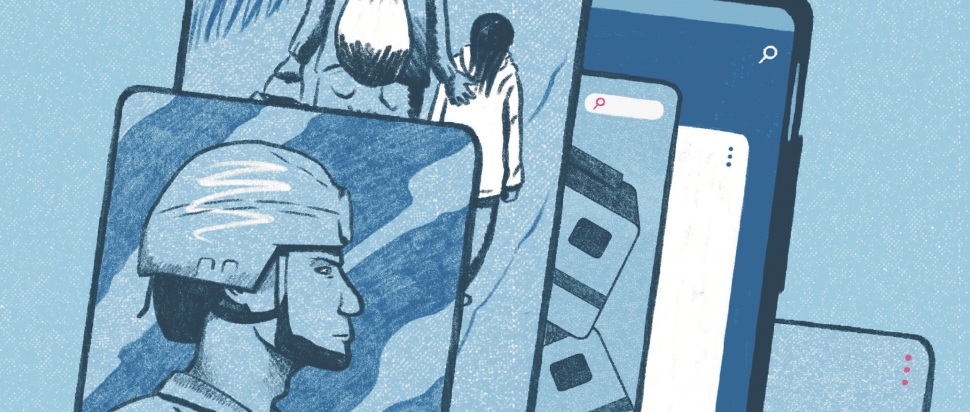Bearing Witness: The value of online activism - now and always
Amid ongoing atrocities, digital engagement is far from futile – rather, it is key in demanding change. One writer reflects on building online solidarity and holding truth in urgent times
Before I sat down to write this, I saw a video of a man holding the body of his infant daughter, wracked with sobs amongst the rubble of Gaza. Wincing, I positioned my thumb so I could read the caption without looking at it, as if the words were less stomach-churning. In the last year, I’ve watched from afar as Russian troops continue to wreak destruction in Ukraine, railway collisions in India kill hundreds and injure thousands, and earthquakes in Turkey and Syria leave millions homeless. Unlocking my phone first thing in the morning has become an exercise in nerve, bracing myself for what I might find on my feed.
In Regarding the Pain of Others, Susan Sontag described being a spectator of suffering as a “quintessential modern experience”, noting how developments in media had reduced the atrocities of war to “living room sights and sounds.” Sontag was writing at the turn of the millennium, and technological developments in the decades since have infinitely multiplied opportunities to encounter suffering; not just victims of war or disaster, but of all facets of human cruelty, local or distant. Those sights and sounds now sit in your pocket to be viewed at any time.
This inescapability creates a heaviness, a profound helplessness such that a common response is to tune it out; we begin to assume that looking at, sharing or posting about the growing list of horrors achieves nothing. As I said, I’ve felt myself try to look away. Indeed, Sontag writes of a “dubious privilege” of those who can decline to be spectators of other people’s pain. Whilst I agree that the choice to look away is a privileged one, I also advocate for a small semantic shift when considering your position in relation to a distant victim of injustice, from that of a spectator to a witness.
Writing my master's thesis, I became preoccupied by the unique ways that witnessing plays out online. Camera phones and social media platforms mean that people are now able to position themselves as witnesses preemptively – think of protestors with their phones raised in defiance, primed to capture any potential incidents of police brutality. When shared online for a potential global audience of millions, those viewers, now witnesses themselves, can share those recordings throughout their networks for others to witness. Visual media platforms like Instagram and TikTok have become powerful venues for activism, where users can digitally bear witness to injustice through the sharing and reproduction of testimony.
A spectator is a passive onlooker, even a voyeur, but witnessing carries a moral responsibility to act upon and relay what is seen. Grappling with the desensitization that comes with a media oversaturated with horror, Sontag argued that passivity is what dulls feeling, noting; “Compassion is an unstable emotion. It needs to be translated into action, or it withers.” Whilst that tug at the chest and the drop of the gut can be despairing when felt alone, when turned into a collective experience it can be galvanising. For me, this means not only turning to face suffering, but sharing what is seen so that others can undergo that same shift. In the case of the ongoing genocide in occupied Gaza – which is, of course, why these questions are arising right now – amplifying online testimonies of those on the ground, be it journalists, doctors, or civilians, should not be dismissed as ineffective.
Bearing witness connotes an assertion of truth, a corroboration of experience as in traditional court testimony. Reaffirming experience shapes how an event endures in collective memory, and is an act of solidarity. For example, content which honoured Brianna Ghey after her death bore witness to both her trans identity and the hateful conditions of her senseless murder amidst a conservative media which denied these truths. And, in the face of staggering state-sanctioned Israeli misinformation, deliberate obfuscation of truth in mainstream media framing and the reported censorship of Palestinian social media accounts, amplifying reports from the ground is vital.
Sontag also urged for a “reflection on how our privileges are located on the same map as their suffering and may – in ways we might prefer not to imagine – be linked” when encountering the pain of another. The way I see it, witnessing must go beyond acknowledging injustice to fostering an understanding that each atrocity does not occur in isolation. When the shock of a news item allows you to recognise a material relationship between you and what you see – for example, how your consumer choices may abet Israel’s system of occupation and apartheid, or how your government has licensed hundreds of millions of pounds worth of arms to a genocidal regime – this creates a course of action. When positioning oneself as a digital witness, developing this consciousness is a strong antidote to that feeling of helplessness.
